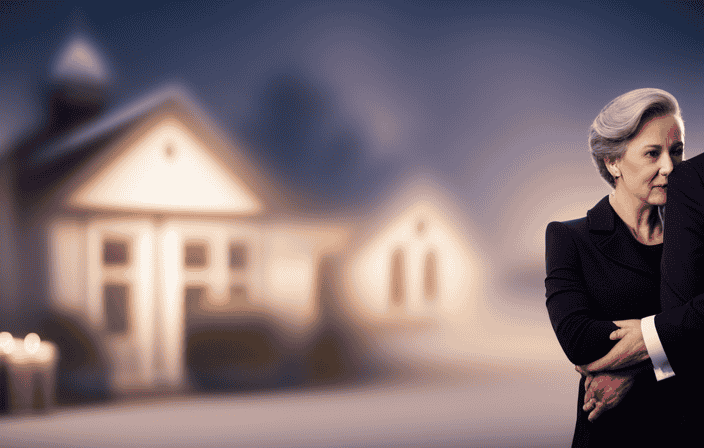Cremation rates have been steadily increasing while burial preferences have been declining. This shift is especially noticeable in urban areas where cremation is preferred for its more eco-friendly practices compared to traditional burials.
This article explores the costs, benefits, and considerations associated with cremation and funeral services. From hidden expenses to ways of reducing costs, we will delve into the pros and cons of cremation, trends in cremation versus burial, the environmental impact of cremation, legal considerations, and the emotional aspects involved.
Join us as we navigate this complex topic and provide valuable insights for your funeral planning needs.
Key Takeaways
- Cremation is generally less expensive than burial and offers flexibility in memorialization.
- Pre-planning funeral services can provide peace of mind, reduce stress, and ensure wishes are followed.
- Factors affecting cremation costs include location, additional services chosen, type of urn selected, and transportation distance.
- Cremation rates have been increasing, while burial rates have been declining, with cremation being more popular in urban areas.
Cremation Basics
Cremation, which is a method of disposing of a deceased person’s body through burning, is a widely accepted alternative to traditional burial methods. The cremation process involves placing the deceased in a cremation container and subjecting it to intense heat, typically around 1,400-2,000 degrees Fahrenheit, until only ashes remain.
Cremation container options include caskets made of materials such as wood, metal, or cardboard, as well as simple containers made specifically for cremation purposes. These options allow for personalization and flexibility in choosing a container that aligns with the deceased’s preferences or budget. It is important to note that certain regulations and guidelines may apply when selecting a cremation container, depending on the crematory and local laws.
Overall, cremation provides an alternative to traditional burial and offers various container options to suit individual preferences and needs.
Costs and Hidden Expenses
One important aspect to consider when planning for end-of-life arrangements is the financial implications and potential hidden fees associated with the process. Cremation alternatives, such as open-casket viewing and burial, can provide cost savings compared to traditional funeral services. However, it is essential to be aware of the various hidden expenses that may arise during the cremation and funeral service planning. These costs include the purchase of a casket, transportation fees, cemetery plot fees, burial fees, funeral home fees, transportation of the body to the crematory, administrative fees, crematory fees, urn purchase, and memorial service expenses. To better understand the financial impact, the table below outlines some of these potential hidden fees in funeral services.
| Hidden Fees in Funeral Services | Average Cost Range |
|---|---|
| Casket | $500 – $20,000 |
| Transportation | $300 – $1,000 |
| Cemetery Plot | $1,000 – $4,000 |
| Burial Fees | $500 – $3,000 |
| Funeral Home Fees | $1,000 – $5,000 |
By being aware of these potential costs, individuals can make informed decisions and plan accordingly to avoid any financial surprises during a difficult time.
Ways to Lower Funeral Costs
To mitigate financial burdens associated with end-of-life arrangements, individuals can explore various strategies to reduce expenses and ensure that their funeral costs align with their budget and preferences.
One option is to consider direct cremation instead of traditional funeral services. Direct cremation involves the immediate cremation of the body without a formal viewing or memorial service, which can significantly lower costs.
Another way to lower funeral costs is to explore affordable alternatives to traditional memorial services. This can include hosting a memorial gathering at a community center or private residence instead of a funeral home, or opting for a simple, intimate gathering with close family and friends.
By considering these options, individuals can find ways to honor their loved ones while also managing their financial obligations.
Pros of Cremation
In considering the advantages of cremation, it becomes evident that this method of disposition offers individuals the opportunity for creative expression and personalization through the selection of unique urn choices. Cremation allows for flexibility in memorialization, providing a range of options to honor the memory of the deceased.
Here are some key benefits of cremation:
-
Creative urn choices: Cremation allows for a wide variety of urn options, ranging from traditional designs to more personalized and creative choices. Families can choose urns that reflect the personality, interests, or hobbies of their loved ones, creating a unique and meaningful tribute.
-
Flexibility in memorialization: Unlike traditional burial, cremation offers more flexibility in how and where the remains are memorialized. Families can choose to scatter the ashes in a meaningful location, keep them at home in an urn, or even incorporate them into keepsake jewelry or artwork.
-
Environmentally friendly: Cremation consumes fewer resources and energy compared to burial, making it a more environmentally friendly option. Additionally, alternative cremation methods, such as alkaline hydrolysis, have even lower environmental impacts.
Overall, cremation provides individuals with the opportunity to personalize and customize their memorialization choices, allowing for a unique and meaningful tribute to their loved ones.
Cons of Cremation
A potential drawback of choosing cremation as a method of disposition is the limited options available for traditional funeral rituals. Unlike burial, where there are established rituals such as viewing the body, having a funeral service, and burying the casket, cremation offers fewer opportunities for these traditional practices. While some families may choose to have a memorial service or celebration of life after the cremation, it may not provide the same level of closure or comfort as a traditional funeral. Additionally, there may be restrictions on the dispersal of cremated remains, which can limit the ability to scatter them in meaningful locations. This can be particularly challenging for individuals who place importance on specific cultural or religious rituals surrounding the handling of the deceased.
| Dispersal Restrictions | Traditional Funeral Rituals |
|---|---|
| Limited options for where remains can be scattered or dispersed | Offers established rituals such as viewing the body, funeral service, and burial |
| May limit the ability to scatter remains in meaningful locations | Provides closure and comfort to grieving loved ones |
| Can be challenging for individuals with specific cultural or religious beliefs | Allows for the expression of grief and mourning in a traditional manner |
Importance of Pre-Planning
Transitioning from the cons of cremation, it is crucial to discuss the importance of pre-planning funeral services.
Pre-planning allows individuals to make decisions about their final arrangements ahead of time, ensuring their wishes are respected and followed. This process provides peace of mind for loved ones, relieving them of the burden of making difficult decisions during a time of grief.
Additionally, pre-planning enables financial planning and budgeting, allowing individuals to consider their options and make informed choices. It also offers an opportunity for funeral service customization, allowing individuals to personalize their arrangements and ensure their unique preferences are honored.
Overall, pre-planning funeral services is a thoughtful and considerate act that provides comfort, reduces stress, and allows for a meaningful and personalized farewell.
To further understand the significance of pre-planning, here are three key aspects to consider:
-
Decision-making relief for loved ones during a time of grief
-
Financial planning and budgeting opportunities
-
Customization options for funeral services.
Factors Affecting Cremation Costs
Factors such as location, chosen services, type of urn, transportation distance, special requests, and customization can significantly impact the overall expenses associated with the cremation process. The cost of cremation can vary depending on the state and region, with some areas having higher fees than others.
Additional services such as memorial services or viewings can also add to the total cost. The type of urn selected can range in price, with more elaborate options being more expensive. Transportation distance to the crematory can also affect costs, especially if the crematory is far from the location of the deceased.
Finally, any special requests or customization, such as personalized urn engravings, may incur additional charges. To reduce cremation expenses, individuals can consider options such as choosing a direct cremation without a funeral service or comparing prices from different funeral homes.
Trends in Cremation vs Burial
Trends in memorialization preferences have shown a steady increase in the popularity of cremation over traditional burial methods, particularly in urban areas. This shift in preference can be attributed to changing societal values and cultural influences. The following bullet list highlights the emotional and practical aspects that have contributed to this trend:
-
Flexibility: Cremation offers more options for memorialization, allowing families to personalize the final farewell.
-
Cost-Effectiveness: Cremation is often seen as a more affordable alternative to burial, especially considering the rising costs of funeral services.
-
Environmental Considerations: With a growing concern for the environment, cremation is viewed as a more eco-friendly option due to its lower energy consumption and avoidance of land use.
-
Changing Attitudes: Cultural influences and religious practices are evolving, making cremation more acceptable and widely practiced.
-
Impact on Funeral Industry: The rise in cremation rates has forced funeral homes to adapt their services, offering more affordable and customizable options for families.
These trends in cremation vs. burial have significant implications for the funeral industry and the services provided by funeral homes.
Environmental Impact of Cremation
One important aspect to consider is the impact of the chosen end-of-life method on the environment, as it has become increasingly relevant in today’s society due to growing concerns about sustainability and carbon footprints.
Cremation, as a popular choice, has its own environmental implications. While traditional cremation does release carbon dioxide and other emissions, alternative cremation methods, such as alkaline hydrolysis, have lower environmental impact. These methods use water and chemicals to break down the body, resulting in a more eco-friendly process. Additionally, some crematories have adopted energy-efficient technologies to minimize energy consumption.
Compared to burial, cremation consumes less energy and resources, and it does not contribute to land use for cemeteries. However, it is worth noting that the environmental impact of cremation is still a topic of discussion and ongoing research.
Legal Considerations for Cremation
In addition to considering the environmental impact of cremation, it is important to be aware of the legal considerations surrounding this practice. Cremation is subject to specific legal requirements and regulations that must be followed. These requirements may vary by state and can include obtaining permits and ensuring that the proper documentation is in place.
Some key legal considerations for cremation include:
-
Cremation legal requirements: Each state has its own laws dictating the process and legal requirements for cremation. It is essential to understand and adhere to these laws to ensure a smooth and lawful cremation process.
-
Cremation regulations and permits: Permission from the next of kin or authorized representative is typically required before cremation can take place. Death certificates and permits may also be necessary. Additionally, cremation may be subject to local zoning and environmental regulations.
By being aware of these legal considerations, individuals can ensure that they comply with the necessary requirements and fulfill the legal obligations associated with cremation.
Emotional and Psychological Aspects
Emotional and psychological factors play a significant role in individuals’ reactions and coping mechanisms when faced with the process of cremation. Cremation vs traditional burial can evoke different emotional responses and cultural and religious beliefs about cremation can also impact individuals’ feelings and attitudes towards this practice.
Cremation offers a sense of closure and finality for some individuals, allowing them to keep the ashes at home or scatter them in meaningful locations. This can provide comfort and a way to remember the deceased. However, others may struggle with the idea of cremation, preferring traditional burial as it aligns with their cultural or religious beliefs.
The grief and mourning process can be influenced by these cultural and religious beliefs surrounding cremation. Each individual’s experience is unique, and professional grief counseling and support services are available for those dealing with loss.
To summarize the emotional and psychological aspects of cremation, the following table provides a comparison between cremation and traditional burial:
| Cremation | Traditional Burial |
|---|---|
| Allows for personalization and flexibility in memorialization | Provides traditional funeral rituals |
| Can evoke a sense of closure and finality for some individuals | Offers a burial site for visitation and remembrance |
| May align with cultural and religious beliefs that encourage cremation | Preferred in some religious or cultural communities |
Understanding and respecting these emotional and psychological factors is crucial when considering cremation as a funeral option.
Frequently Asked Questions
Are there any options for memorializing a loved one’s cremated remains other than scattering them or keeping them in an urn?
There are various memorialization options for a loved one’s cremated remains, beyond scattering or keeping them in an urn. Unique keepsakes include jewelry, artwork, and memorial diamonds made from the ashes. These options allow for personalized and meaningful tributes.
How do cremation costs vary between different states and regions?
Cremation costs can vary between states and regions due to factors such as location, additional services chosen, and transportation distance to the crematory. However, it is important to consider alternative memorial options that may help lower costs and personalize the process.
What are the benefits of opting for a direct cremation without a funeral service?
Opting for a direct cremation without a funeral service offers several benefits, including affordability and simplicity. It allows for a more cost-effective option while still providing an opportunity to honor and remember the deceased.
Can you still have a traditional funeral with a viewing if you choose cremation?
Yes, it is possible to have a traditional funeral with a viewing if you choose cremation. Funeral homes can accommodate this request by providing a visitation or viewing prior to the cremation process. Funeral alternatives for cremated remains include burial, scattering, or placement in a niche or columbarium.
Are there any financial assistance programs available to help cover the costs of cremation and funeral services?
Financial assistance programs are available to help cover the costs of cremation and funeral services. These programs aim to provide support and relief to individuals and families who may be facing financial difficulties during a difficult time.










